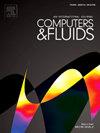A generalized correction scheme for two-way coupled particle-laden Euler–Lagrange simulations
IF 2.5
3区 工程技术
Q3 COMPUTER SCIENCE, INTERDISCIPLINARY APPLICATIONS
引用次数: 0
Abstract
A two-way coupled, , Euler–Lagrange point particle formulation is proposed that takes into consideration the disturbance in the flow caused by the dispersed particles to obtain the undisturbed fluid flow field essential for the accurate computation of force closure models. Specifically, an advection–diffusion–reaction (ADR) equation for Stokes flow developed by Pakseresht and Apte (Pakseresht and Apte, 2021) for obtaining the disturbance flow field created by the particle is extended to non-Stokesian flow conditions. Using the solution for flow over a cylinder, an ADR equation for obtaining the disturbance flow field created by a particle in pseudo- flows is derived. The present technique for non-Stokesian flows performs significantly better than the existing Stokesian correction scheme, especially for higher particle Stokes numbers and particle-to-grid spacing ratios. The extension of the present technique to the porous particles is examined using two test cases, namely, the settling of porous particles under gravity in a quiescent fluid and porous particles subjected to the oscillating body force field. The present technique is straightforward to implement in all existing Euler–Lagrange solvers based on either ADR or zonal-advection–diffusion–reaction (Zonal-ADR) model.
双向耦合载粒子欧拉-拉格朗日模拟的一种广义修正方案
提出了一种双向耦合的三维欧拉-拉格朗日点粒子公式,该公式考虑了分散粒子对流动造成的干扰,从而获得了精确计算力闭合模型所必需的无扰动流体流场。具体来说,Pakseresht和Apte (Pakseresht和Apte, 2021)建立的Stokes流动平流-扩散-反应(ADR)方程(Pakseresht和Apte, 2021)用于获得颗粒产生的扰动流场,并将其推广到非stokesian流动条件下。利用圆柱流动的解,导出了伪二维流动中粒子扰动流场的ADR方程。该方法对非斯托克流的校正效果明显优于现有的斯托克流校正方法,特别是在高粒子斯托克数和粒子与网格间距比的情况下。通过两个测试案例,即多孔颗粒在静止流体中重力作用下的沉降和多孔颗粒在振荡体力场作用下的沉降,检验了本技术对多孔颗粒的扩展。该方法可以在现有的基于ADR或纬向-平流-扩散-反应(纬向-ADR)模型的欧拉-拉格朗日解算器中实现。
本文章由计算机程序翻译,如有差异,请以英文原文为准。
求助全文
约1分钟内获得全文
求助全文
来源期刊

Computers & Fluids
物理-计算机:跨学科应用
CiteScore
5.30
自引率
7.10%
发文量
242
审稿时长
10.8 months
期刊介绍:
Computers & Fluids is multidisciplinary. The term ''fluid'' is interpreted in the broadest sense. Hydro- and aerodynamics, high-speed and physical gas dynamics, turbulence and flow stability, multiphase flow, rheology, tribology and fluid-structure interaction are all of interest, provided that computer technique plays a significant role in the associated studies or design methodology.
 求助内容:
求助内容: 应助结果提醒方式:
应助结果提醒方式:


